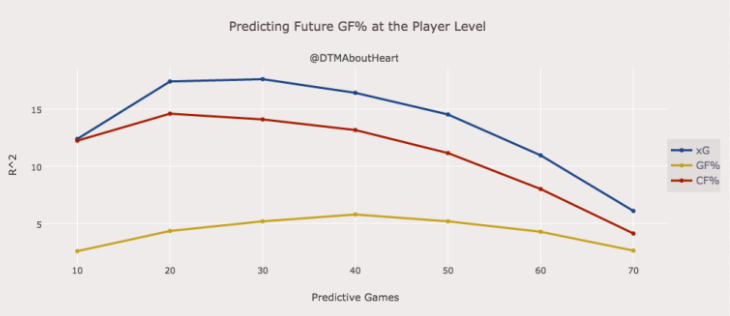Franckie Burns Bästa sammanfattningen av plus/minus jag läst. Hatten av!
Franckie Burns Plus-minus har alltid varit ett trubbigt mått - det gäller framförallt när urvalet är litet (“small sample size” som de säger). Målchanser och skott framåt respektive bakåt säger mer då skottprocent och räddningsprocent jämnar ut sig över tid. Skapar man konsekvent chanser så kommer puckarna börja gå in till slut. Släpper man konsekvent till chanser bakåt så kommer det börja ringa åt det hållet, svårare än så är det inte. Blivande GM @Hank får gärna komma in och nyansera detta om han tycker att jag ger en missvisande bild.
Exakt så. Att tillägga i fallet med Maxwell är även att han ligger på en ohållbar PDO-nivå på 92 (lägst i laget), men ligger på 55% i Corsi (bäst i laget).
För den som vill läsa lite mer så finns det artiklar som denna:
Plus-minus is the most useless and misleading statistic in hockey analytics today
Plus-minus is a terrible number for measuring how good a player is.
…
The amount of control an individual player has over their own plus-minus is very tiny. Players make mistakes all the time. They can also excel at times. All too often, goals are scored, and you had nothing to do with it.
…
Plus-minus is very flawed. It really shouldn’t be used anymore, as Corsi and Fenwick are better indicators. Shots are inherently a far bigger sample size than goals, and we should acknowledge this.
och denna:
Why Plus/Minus is the worst statistic in hockey and should be abolished
Don’t get me wrong, goals are the end objective, and in the very long run it should be worth at least a look, but we also know that sometimes players get lucky bounces, or that goaltenders steal games. This uncertainty means we can’t rely on goals for predictivity.
…
Combining a rare event with highly variable confounding variables and you get a number that takes a very long while to settle. With plus/minus, this often means multiple seasons.
…
Looking at goals as a measure of outscoring doesn’t necessarily tell you who will outscore in the future, and we have far more effective means in determining who will.
Det finns studier på hur bra olika statistika mått är på att förutse framtida resultat. Här är en som visar just detta, där man har jämfört xG, Corsi (CF%) och plus/minus (GF%).:

Expected Goals (xG) significantly outperforms score-adjusted Corsi (CF%) and Goals For (GF%) in predicting future goals at the team and player levels.